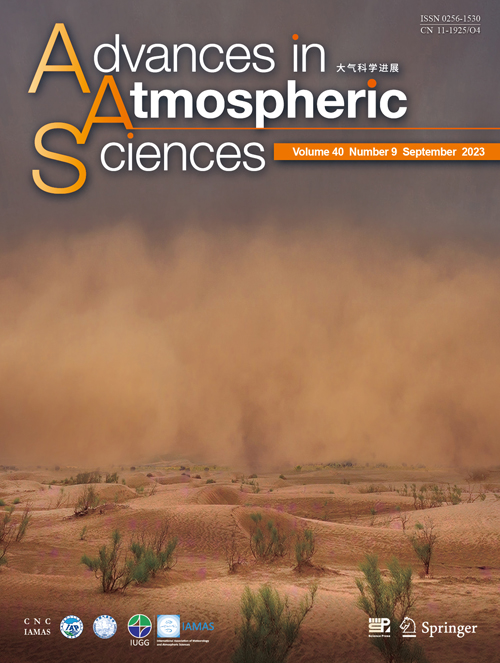Dust storms are one of the most frequent meteorological disasters in China, endangering agricultural production, transportation, air quality and the safety of people's lives and properties. A research team has conducted a study of a series of dust storms that originated in Mongolia and spread into China in March and April, 2023.
The frequent dust storms that began in March 2023 have been affecting the northwestern and northern regions of China. The team's study revealed that a cold high-pressure center, a cold front, and a Mongolian cyclone resulted in the transport of dust aerosols from Mongolia into China. "Mongolia has become the main dust source that affects the air quality in China, with a larger dust concentration contribution to China than that from Taklimakan Desert," said CHEN Siyu from Lanzhou University. During dust events in March and April, Mongolia was responsible for approximately 42% of dust concentrations experienced by China, while the Taklamakan Desert contributed 26%. Moreover, XGBoost-SMOTE performed well in predicting hourly PM10 concentrations in March, 2023 based on ground observations and WRF-Chem simulations over East Asia. "Based on our analysis, we can provide a reference for the prediction of dust events in China, which will help to address the global issue of dust storm hazards," said CHEN.
Dust storms are a common weather disaster in northern China, characterized by their suddenness and severity. China's efforts to control the desertification, where fertile areas become desert, have proven effective. Yet dust storms continue to occur frequently each spring. In addition to local dust, the impact of cross-border dust cannot be ignored. Nearly 90% of Mongolia’s land area, which borders China, is experiencing desertification. Mongolia is located in the upstream of China, becoming the most important foreign dust source area, and posing a serious threat to the construction of an ecological security barrier in northern China.
The study is featured on the cover of issue 9, 2023 of Advances in Atmospheric Sciences. (Image by Advances in Atmospheric Sciences)
Driven by global warming, increasing population, over-cultivation and grazing, Mongolia's ecosystem has suffered serious damage in recent years. Mongolia's limited meteorological modernization capabilities and insufficient regional collaborative observation networks have limited its ability to prevent and control desertification. Currently, desertification monitoring primarily focuses on local and short-term observation due to these challenges. "Mongolia lacks long-term and high spatial-temporal resolution desertification data sets, and is unable to provide perfect meteorological data information, which seriously restricts the dust forecast level in China. To better prevent and predict dust storms, it is crucial to accurately investigate the impact of local dust and cross-border dust on China," said HUANG Jianping from Lanzhou University. HUANG is also a member of the Chinese Academy of Sciences.
For their study, the team used the Weather Research and Forecasting model coupled with Chemistry (WRF-Chem) and the dynamic dust source and the HYSPLIT model to analyze the dust storms. They combined multi-source and multi-scale data, synoptic analysis, and trajectory analysis to investigate the causes of the prolonged period of heavy dust pollution weather that occurred in China during March and April 2023. Moreover, two machine learning methods were used to forecast the dust storms in March, 2023 based on ground observations and WRF-Chem simulations over East Asia.
Because of the complex physical processes, the accuracy of dust process simulation in numerical models is closely related to dust emission. Dust emission is a prerequisite for accurate simulation of the dust cycle in numerical models. Current numerical models only consider permanent deserts as the dust sources and seriously ignore the potential impact of other land covers on dust emission. "Our results show that the numerical model coupled with the dynamic dust sources can accurately characterize the dust emission in the Gobi Desert in Mongolia. Moreover, we have also shown that Mongolia has emerged as the main dust source affecting the air quality in China, with the dust concentration contributions mainly exceeding 40%." said CHEN.
The team conducted their research to identify and forecast cross-border dust hazards, focusing on two main aspects. First, they conducted comprehensive observation experiments to obtain the transport channels of cross-border dust in Mongolia, improving the forecasting capability of numerical models. Second, they used big data analysis techniques to fuse multi-source meteorological observations as well as model simulation, to build a refined dust weather forecasting model based on deep learning, and to develop a refined dust weather forecasting system with high spatial-temporal resolution.
"Compared with previous studies, based on numerical models and a large number of observational facts, our results not only reveal the Mongolian dust transboundary transport path and physical mechanism, but also clarify the specific dust contribution in Mongolia to that in northern China," said HUANG.
Media contact:
Ms. LIN Zheng
Email: jennylin@mail.iap.ac.cn
Tel: 86-10-82995053
http://english.iap.cas.cn/

